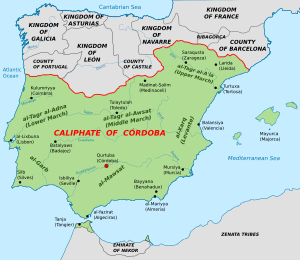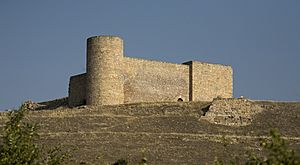Ghalib ibn Abd al-Rahman facts for kids
Ghālib ibn ʿAbd al-Raḥmān al-Nāṣirī (born around 900, died July 10, 981) was a very important military leader in the Caliphate of Córdoba. This was a powerful Muslim kingdom in what is now Spain. Ghālib served three different rulers, called caliphs: ʿAbd al-Raḥmān III, al-Ḥakam II, and Hishām II. He led armies on land and fleets at sea. Because he was such a skilled fighter, he was given a special title: Dhu ʾl-Sayfayn, which means "Lord of the Two Swords."
Ghālib became more important after Caliph ʿAbd al-Raḥmān III stopped leading armies himself. In the 940s, Ghālib helped the caliphate control cities like Toledo and Medinaceli. In the 950s, he led many raids into Christian lands to the north. These raids brought back valuable goods and prisoners. In 955, he even led a naval attack against the Fatimid Caliphate in North Africa.
Under Caliph al-Ḥakam II, Ghālib became the public face of the caliphate. He was seen as a hero. People celebrated when he left for campaigns and when he returned to Córdoba. He continued to lead attacks into Christian lands in the 960s and 970s. He also helped defend against Vikings in 971–972. One of his biggest achievements was bringing the Idrisid dynasty in North Africa back under the caliphate's control in 973.
In his last year, Ghālib had a big conflict with his son-in-law, Ibn Abī ʿĀmir (who later became known as Almanzor). Ghālib had to team up with his former Christian enemies. He was defeated and killed in a major battle. His death helped Ibn Abī ʿĀmir become the most powerful person in the caliphate.
Contents
Who Was Ghālib?
Ghālib was originally a Ṣiḳlabī. This means he was a slave, probably from Eastern Europe, and from a Christian family. Caliph ʿAbd al-Raḥmān III owned him and later set him free. When a slave was freed, they became a mawlā (freed person). It was common for them to take their former owner's name as part of their own. This is why Ghālib became ibn ʿAbd al-Raḥmān al-Nāṣirī, meaning "son of ʿAbd al-Raḥmān, the supporter."
Military Campaigns
In 946, Ghālib was put in charge of the Middle March. This was a border area. He rebuilt the castle of Medinaceli and used it as a base. From there, he often attacked the Christian kingdom of León. In 953, he attacked the Leonese county of Castile. He brought back many prisoners and valuable items. However, the border did not change much.
In 954, a fleet from Sicily, sent by the Fāṭimid caliph al-Muʿizz, attacked the city of Almería. The next year, Ghālib led a naval attack on the coast of Fāṭimid Ifrīḳiya (Africa). This first attack was not very successful. But in 956, a second expedition with seventy ships captured and destroyed Marsā al-Kharaz. They also took goods from Ṭabarḳa and Sūsa.
In 960, Caliph ʿAbd al-Raḥmān III helped Sancho I get his throne back in León. In return, Sancho promised to hand over ten border forts. But the caliph died in 961 before this happened. Sancho's rival, Ordoño IV, fled to Count Fernán González of Castile. The count sent Ordoño as a prisoner to Ghālib at Medinaceli. Ghālib then sent him to Córdoba. There, the new caliph, al-Ḥakam II, met with Ordoño in 962. Ordoño agreed to the deal if he could become king.
Before this new deal could happen, Sancho I promised again to give up the ten forts. Ordoño IV died soon after. Then, Sancho broke his promise. He teamed up with the Kingdom of Navarre and the County of Barcelona to attack the caliphate. Caliph al-Ḥakam II led an army to the border in 963. He captured the forts of Gormaz and Atienza. At the same time, Ghālib and Yaḥyā ibn Muḥammad al-Tujībī, the governor of Zaragoza, attacked Navarre from two sides. Ghālib captured Calahorra from the Navarrese. Al-Tujībī defeated their king, García Sánchez I, in battle.
Becoming Supreme Commander
By 971, Ghālib had the high rank of vizier (a top advisor). On July 3, the Caliph al-Ḥakam asked him to lead a campaign against a Viking fleet. This fleet had appeared off the Atlantic coast. Ghālib made his preparations and left on July 12. His departure was a big ceremony. However, he seemed to be too late. An embassy from León arrived with news that the Vikings had gone up the river Duero. They had left without taking anything. Ghālib's fleet did not sail until late July. The fleet did not find the Vikings and returned a month later. Still, a celebration was held for Ghālib. He was escorted into Córdoba with many banners. A poem was even written to honor him.
In 972, Ghālib was promoted to a new, even higher rank: al-qāʾid al-aʿlā, which means "supreme commander." In 974, special documents were given to the lords of the Middle March at Ghālib's request. These documents described Ghālib as the zaʿīm (boss) of these lords. He was at the peak of his power. In 973, he was sent to Africa to bring the Idrisid dynasty back under the caliphate's control. They had joined the Fāṭimids in 958. Ghālib returned to Córdoba in triumph in September 974. He brought the captured Idrīsid leader, al-Ḥasan ibn Gannūn, with him. The Idrīsid ruler had to promise loyalty to the caliphate.
In 975, Ghālib led an attack against an alliance of León and Navarre. He won two big victories. On June 28, he defeated the allied army that was attacking Gormaz. On July 8, he defeated Count García Fernández of Castile near Langa. After these victories, he was given two golden swords. He also received the special title Dhu ʾl-Sayfayn (Lord of the Two Swords). Only the caliph, his son Hishām, and his first minister were at the ceremony. Ghālib set up his headquarters at Medinaceli. He hired Ibn Abī ʿĀmir, who would later become a powerful ruler, as his chief manager. Many others joined Ghālib because of his new honors.
Conflict with Ibn Abī ʿĀmir
After Hishām II became caliph in October 976, Ghālib took command of the military in the capital. Ibn Abī ʿĀmir followed him there. In 978, Ibn Abī ʿĀmir married Ghālib's daughter, Asmāʾ. In the capital, Ibn Abī ʿĀmir first worked with another minister to remove some palace guards. Then, he worked with Ghālib to remove that minister. Ibn Abī ʿĀmir rewarded Ghālib by getting him the title dhu ʾl-wizāratayn ("he of the two vizierates") from the young Caliph Hishām II. This title made Ghālib the most important of all the viziers at court.
However, Ghālib and his son-in-law soon had a disagreement. Ibn Abī ʿĀmir was limiting the young caliph's activities to only religious ceremonies. In 980, Ghālib asked to meet Ibn Abī ʿĀmir at his castle in Medinaceli. According to old stories, Ghālib got angry during the meeting and hit his son-in-law with his sword, injuring him.
With their conflict now out in the open, Ibn Abī ʿĀmir took Medinaceli with a large army. To get his land back, Ghālib allied with Castile and the Kingdom of Viguera. He won several battles against his son-in-law's forces. But Ibn Abī ʿĀmir forced him into a major battle. Even though Ibn Abī ʿĀmir's own army had Christian soldiers, he declared a holy war against Ghālib because Ghālib had Christian allies. The Battle of Torrevicente took place on July 10, 981. The king of Viguera, Ramiro Garcés, was killed. Ghālib himself died when his horse stumbled. He was about eighty years old. This victory over his last rival helped Ibn Abī ʿĀmir get the title al-Manṣūr bi-Llāh, meaning "Victorious by God." This is the name he is most known by.
See also
In Spanish: Gálib para niños



